More Architectural Design
Tom Kelliher, CS 319
Next Lecture
- Sign-offs.
- Control models.
- Modular decomposition.
- Domain Specific Architectures.
Read Chapter 14.
Centralized and event-driven.
- One sub-system designated controller and has responsibility for
managing execution of other sub-systems.
- Two models:
- Call-Return model: Subroutines. Familiar programming language
control. Only applicable to sequential systems.
Applicable as a module control mechanism for controlling functions or
objects.
- Manager model: Sub-Systems are parallel processes. System manager
controls the start, stop, and coordination of other system processes.
Sequential variation: manager sequentially calls other sub-systems as
determined by global system state variables.
- Example:
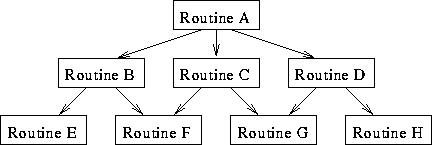
Note: this does not imply anything regarding structure.
- Control is expected to return to where it came from.
- Advantages: relatively simple to analyze control flow and determine
response to inputs.
- Disadvantages: Exception handling is difficult. You either break the
model or introduce a lot of redundant error-checking code.
- Manager model example of a ``soft'' real-time system:
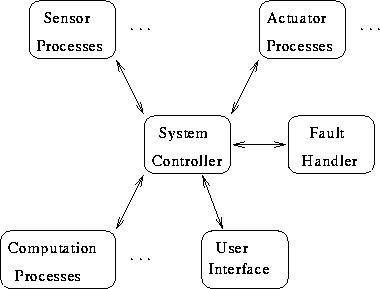
- Another example: telnetd.
- Driven by externally generated events rather than system state
variables.
- An event is an abstract signal with a range of values. Its
timing is not controlled by the system.
- Examples: recalculation in a spreadsheet, rule-based expert systems,
dataflow processing, physical I/O in an operating system.
- Two models:
- Broadcast:
- Events are ``broadcast'' to all sub-systems. Any sub-systems
designed to handle that event respond. Useful in a distributed
environment.
- Sub-Systems register an interest in events. When event occurs,
event handler dispatches event to sub-system(s). (This is the
``broadcast.'')
- Distinction between this and central control.
- Sub-System communication via messages possible.
- Advantages: Simple to evolve system by adding new sub-systems
which register their events. A sub-system can communicate with other
sub-systems without knowing their names. The distributed nature is
transparent.
- Disadvantages: Not knowing if/when a particular event will be
handled. Not knowing how many responses will be generated.
How easy will it be to trace control sequences, consider that
sub-systems will be entering and registering their interests in
events.
- Example:
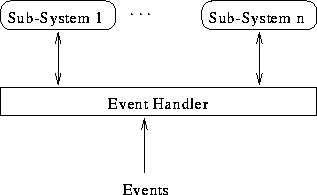
- Interrupt-driven:
- Interrupt handler fields event and passes it off to the
appropriate sub-system. Used in real-time systems with hard
deadlines.
- Key: quick response. Achieved by table of interrupt vectors.
- Example:
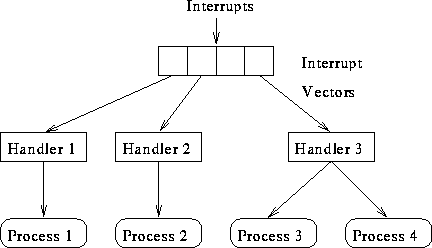
- Vehicle airbag controller. Space shuttle control surfaces.
- Advantages: Very quick event responses.
- Disadvantages: Programming complexity, difficulty in
validation, difficulty in replicating interrupt timing. Making
changes if hardwares limits the system to a small number of
interrupts (unless interrupts are shared, which then requires polling
and slows response time).
Interrupt limitation example: the PC and the ISA bus. Solution: the
PCI bus.
Modules are smaller than sub-systems, allowing alternative decomposition
models. The previous models could still be used, though.
Defer the concurrency question as long as possible. Why?
- System is decomposed into a set of communicating objects. Loosely
coupled objects with well-defined interfaces.
- Invoice processing system example:
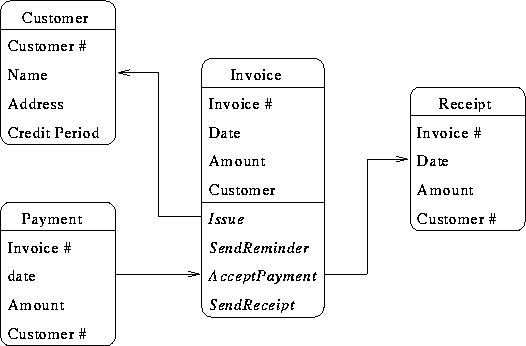
- A control model must be picked.
- Advantages: Loose coupling eases changes. Model of real-world
increases understanding. Object reuse.
- Disadvantages: Naming and knowledge of interface make changes to
those aspects difficult/impossible. Large, complex entities can be
difficult to model.
- System is decomposed into a set of functional filters. AKA pipeline
approach.
- Invoice processing system example:

Less abstract than object model, processing sequence specified.
- Sequential or parallel. Item-by-item or batch processing.
- Batch sequential model for data processing systems. Billing, etc.
- Advantages: Reuse. Intuitive, because of worker's in/out boxes.
Adding new transformations is simple. Implementation as either sequential
or concurrent system feasible.
- Disadvantages: Common data exchange format required. (Unix solution:
file model.) Difficulty in designing GUI interactive (events) systems.
- Generic models: Derived from a number of real systems.
``Bottom-Up.'' Capture principal characteristics. Describe a limited
class of system.
- Reference architectures: More abstract, describing a larger class of
system. ``Top-Down.'' Not based upon real systems. Instead, reflect
application domain.
- A compiler as the classic example:
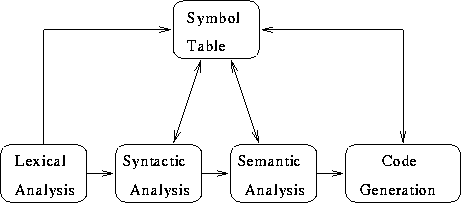
- Contrast with the repository model of a compiler.
- A standard which can be used to compare real systems. Introduces
terminology to an application domain.
- OSI reference model as the classic example:
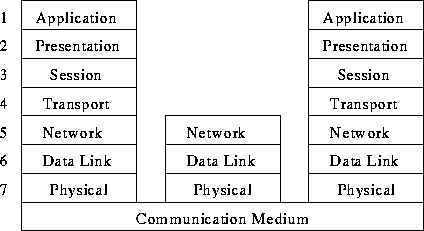
- Intended to promote interconnection of conformant systems. A
failure. Layering subverted.
Thomas P. Kelliher
Wed Nov 11 08:59:40 EST 1998
Tom Kelliher







